Setting, Typical & Stereotypical
When does a setting become too typical? When is it overused to the point of being a stereotype? How should a writer fulfill the expectations of readers, supply the tropes that make a story’s locale fit its genre, and yet avoid cliche?
This balancing act is not easy. Meeting the challenge of being fresh–even original–while making readers happy can twist writers into knots of indecision.
Ultimately the solution comes down to an author’s intent, tone, and approach.
Intent:
Are you aiming for a light, whimsical story that will hit a few key elements of location without going into marked detail?
Are you instead creating a serious drama?
Are you striving to supply a backdrop that’s never been used before, one that will startle or even astonish readers?
Tone:
Serious? Light? Moody? Romantic? Creepy? Hilarious? Cynical? Suspenseful? Terrifying? What is it you want your setting to do for your story? Choose any of these suggestions or come up with your own, but be anything but dull, bland, or generic.
Approach:
Choose your setting. Decide on your story opening. Pick the initial scene action. Introduce your characters. Draw on the physical senses to embrace where your story takes place.
These seem like obvious decisions, yet they can’t be neglected or tossed together haphazardly without thought. If the tone doesn’t jive with the intent, or the approach contradicts the tone–details and description will seem subsequently contrived or phony.
Above all, meeting reader expectations may supersede everything else. It’s possible to be original and fail to convince readers the setting is plausible. Too fresh or too different from the norm may contradict audience belief because in certain stories in certain genres, readers want certain elements.
Because we’re approaching Halloween weekend as I type this, I’m going to borrow examples from the classic tale of terror, Dracula by Bram Stoker.
The first image that springs to my mind is Bran Castle in Transylvania.
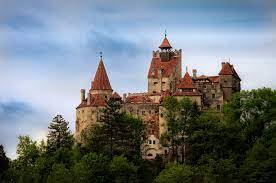 [Bran Castle]
[Bran Castle]Although this real castle belonged to Vlad the Impaler, who lived in the 15th century and got his name from impaling his enemies on iron stakes, and although Mr. Stoker drew on Vlad to some degree for inspiration in creating his character Count Dracula, this castle was not the actual setting for the novel. Only through the efforts of Romanian tourism did Bran Castle come to be known as Dracula’s castle. Prior to COVID, you could tour Bran Castle and even spend the night there.
But is this really what Bram Stoker had in mind?
Let’s back up a bit to the novel itself. Stoker described a “ruin of a castle in the Carpathian Mountains.” He mentioned great round arches, immense iron-studded doors, rattling chains, massive bolts clanking, and long passageways.
Well, okay. Those are specific details. They seem plausible enough, if a bit threadbare. However, let’s remember that Stoker came first. Then Hollywood jumped in with visual images that were so effective they became imitated again and again.
 [This is Orava Castle in Slovakia, used as the setting for Count Orlok in the 1922 silent film, Nosferatu.]
[This is Orava Castle in Slovakia, used as the setting for Count Orlok in the 1922 silent film, Nosferatu.]
 [This depiction of Count Orlok shows him standing beneath a huge round arch of a doorway, true to Stoker’s description.]
[This depiction of Count Orlok shows him standing beneath a huge round arch of a doorway, true to Stoker’s description.]
 [Dracula’s castle from the Spanish version of the 1931 film starring Bela Lugosi.]
[Dracula’s castle from the Spanish version of the 1931 film starring Bela Lugosi.]Here, Hollywood created the rugged mountains and a creepy mass of towering stone walls that should make any viewer think, let’s not go in there. Time to turn back.
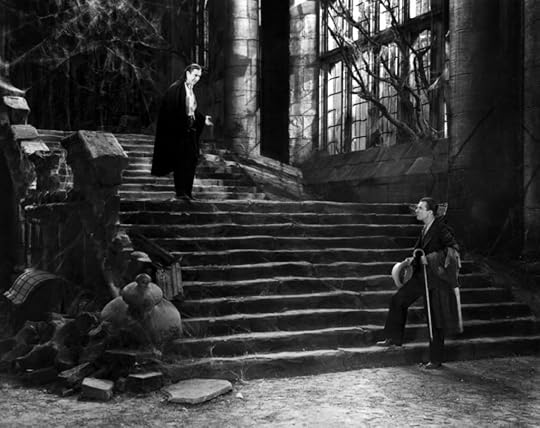 [Again, from 1931’s Dracula. The set is well designed to convey ruin, decay, arched spaces, and immensity. Note the crumbling stone staircase newel and the tree growing through the window.]
[Again, from 1931’s Dracula. The set is well designed to convey ruin, decay, arched spaces, and immensity. Note the crumbling stone staircase newel and the tree growing through the window.]Universal Studios really nailed (pun intended) the sets. So much so that even in 1992, when Dracula was remade yet again, the setting didn’t truly change. Starting in 1958, Hammer Studios put Christopher Lee in the role but kept the usual setting.
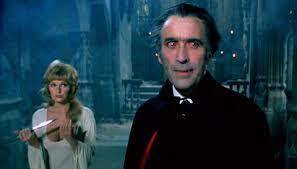 [Christopher Lee up to no good before Peter Cushing as Van Helsing manages to stake his heart.]
[Christopher Lee up to no good before Peter Cushing as Van Helsing manages to stake his heart.]
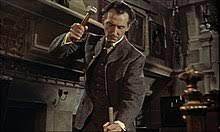 [Van Helsing at work in a Hammer classic film.]
[Van Helsing at work in a Hammer classic film.]
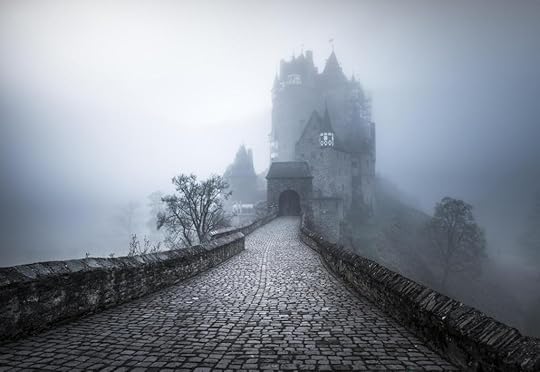 [The castle from the 1992 version of
Dracula
. Back again to the same old standard.]
[The castle from the 1992 version of
Dracula
. Back again to the same old standard.]What can be done that’s different? Well, there’s the 1979 comedic parody, Love at First Bite, starring George Hamilton and Susan St. James, that has the count kicked out of his castle by a communist Romanian government. Homeless, he’s forced to travel to New York City where no one’s afraid of him and disco dancing is all the rage. It’s a funny film because the count is a fish out of water. To the extent of the tone and approach the filmmakers wanted, it succeeds. But is it the Dracula most audiences think of or long to see? Not quite.
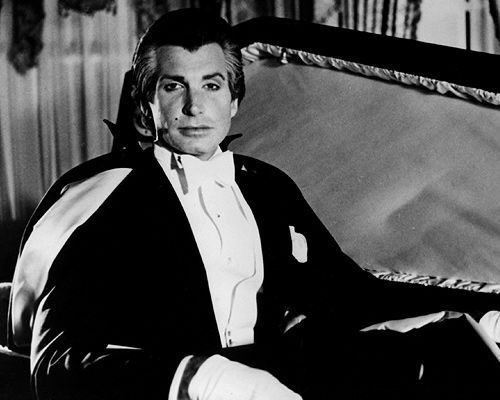 [George Hamilton in the 1979 Love at First Bite.]
[George Hamilton in the 1979 Love at First Bite.]
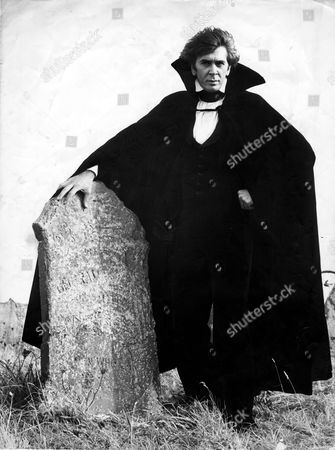 [Mandatory Credit: Photo by Daily Mail/Shutterstock (897295a) Film: Dracula (1979) Starring Frank Langella As Dracula Film: Dracula (1979) Starring Frank Langella As Dracula]
[Mandatory Credit: Photo by Daily Mail/Shutterstock (897295a) Film: Dracula (1979) Starring Frank Langella As Dracula Film: Dracula (1979) Starring Frank Langella As Dracula]Both of these 1979 films took Dracula to new settings. But unlike Love at First Bite, the Frank Langella version stayed in the 19th century and kept the count in cemeteries and old stone crypts.
In 2004, the film Van Helsing kept a similar look to the backdrop but relied on special effects and monstrous creatures.
So what’s the answer? When in doubt, study the actual setting. Find the reality and use that as a foundation. To repeat Stoker’s description from the novel: “a ruin of a castle in the Carpathian mountains.”
I ran a Google search for those mountains, which span across Romania, Poland, and the Ukraine. I also looked up ruined castles in that region. Here’s what turned up:
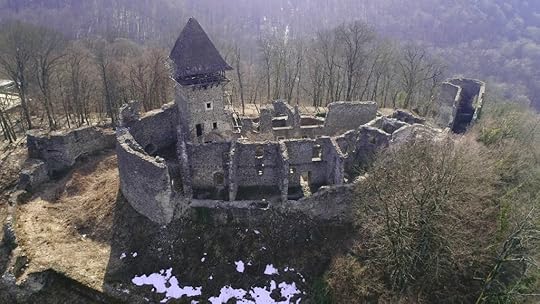 [A Carpathian castle ruin.]
[A Carpathian castle ruin.]Hmm. Looks like the set designers all the way back to the 1920s did their research. Looks like Mr. Stoker did also. So the commonalities are therefore typical of the setting. They are true to the story. They are plausible. They are authentically creepy. They are what readers–or film goers–expect. At some point, a writer must decide whether to buck a tradition this powerful or accept it and use it. If the latter, offer your audience originality elsewhere in the story to compensate.
Even better, create a new predator character of your own instead of clinging to old Dracula’s cape.
C. Aubrey Hall's Blog
- C. Aubrey Hall's profile
- 7 followers



